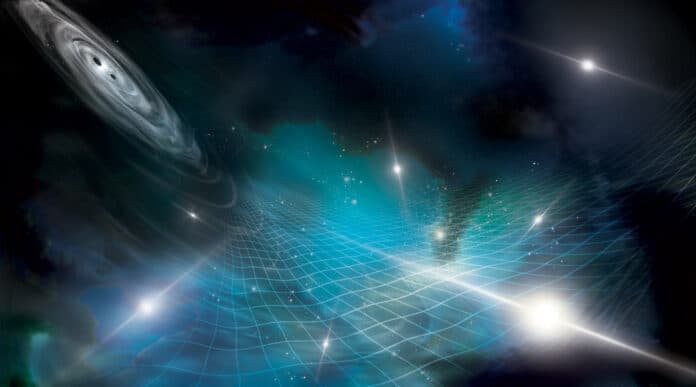Scientists revealed the first proof of a cosmic gravitational wave background on June 28. Supermassive black holes up to billions of times as massive as our Sun are thought to have formed these waves over millions of years as they encircled one another before merging.
Although gravitational waves were foreseen by Albert Einstein 100 years ago, direct detection of them requires astounding technological prowess and a long history of searching. The gravitational waves were first detected in 2015 by LIGO.
After that historical discovery, scientists rediscovered monster gravitational waves with a different technique. The discovery offers the first evidence that our Earth and the universe around us are awash in a background of spacetime undulations called gravitational waves.
Scientists may be able to learn more from the background ripples discovered by NANOGrav about the origin of gravitational waves and what happens to them as they travel through space. Supermassive black hole mergers, which can endure for millions of years, could also be studied using them. According to scientists, these mergers are common in galaxies and impact how they evolve.
Detecting the gravitational wave background is like hearing the murmur of a group of people when everyone is talking, but you can’t pick out any one person’s voice. In the new studies, NANOGrav is thought to have picked up a collective hum of gravitational waves from many pairs of merging supermassive black holes throughout the universe.
NANOGrav used data from radio telescopes—the Arecibo Observatory in Puerto Rico, the Green Bank Telescope in West Virginia, and the Very Large Array in New Mexico—to monitor 68 dead stars, called pulsars, in the sky. The pulsars acted like a network of buoys bobbing on a slow-rolling sea of gravitational waves.
Joseph Lazio, a NANOGrav team member, a principal scientist at the Jet Propulsion Laboratory (JPL), and a visiting associate in astronomy at Caltech, which manages JPL for NASA, said, “We have a new way of probing what happens as monstrous black holes at the cores of galaxies begin a slow but inexorable death spiral. We think this process is standard for many galaxies, and we’ve seen many examples at various steps, but we’re finally starting to glimpse one of the key final steps.”
Michele Vallisneri, a NANOgrav team member, a senior research scientist at JPL, and a visiting associate in theoretical astrophysics at Caltech, said, “To tease out the gravitational-wave background, we had to nail down a multitude of confusing effects, such as the motion of the pulsars, the perturbations due to the free electrons in our galaxy, the instabilities of the reference clocks at the radio observatories, and even the precise location of the center of the solar system, which we determined with help from NASA’s Juno and Cassini missions.”
The scientists hope to answer mysteries about the nature of merging supermassive black holes, such as how common they are, what brings them together, and what other factors contribute to their coalescence.
A series of papers detailing the new NANOGrav results have been accepted for publication in The Astrophysical Journal Letters.
Journal Reference:
- Gabriella Agazie, Akash Anumarlapudi, Anne M. Archibald et al. The NANOGrav 15 yr Data Set: Evidence for a Gravitational-wave Background. The Astrophysical Journal Letters. DOI 10.3847/2041-8213/acdac6
